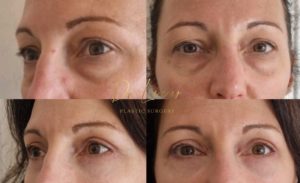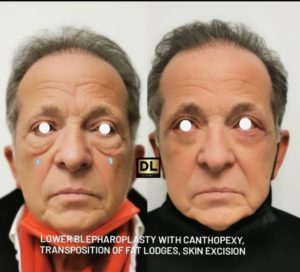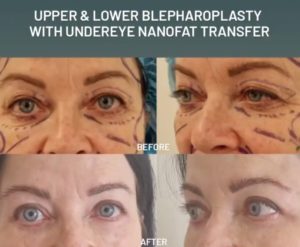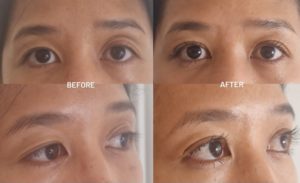Ideal anatomy and proportions:
Excessive skin on the top of the eyes or bags under the eyes can make the eyes look tired, stressed or even sad. Blepharoplasty is a surgical treatment in which we remove extra skin and eliminate excess fat pockets and other deep structures to reduce the puffy appearance of the eyelids.
Bulging is often due to excess of the fat loges (fatty degeneration) that occurs over time: there are 2 fat pockets at the upper level, 3 at the lower level.

A young eye is defined by an eyebrow in an ideal position to the brow lift, a deep and well-defined upper crease that does not come into contact with the eyelashes (distance from upper crease to eyelashes: 8-10 mm, distance from upper crease to eyebrow: 12-16 mm), and a smooth lower eyelid without hollows or pockets. The orientation of the eye “tilt canthal” canthopexy should be neutral or slightly rising towards the temples (lateral canthus 1-2 mm above the medial canthus).
Technique:
The upper scar is located in the natural crease of the eyelid which is almost invisible at 10 days after the procedure. The upper blepharoplasty (or eyelid surgery) consists of excising the excess skin and sometimes, lifting the lacrimal gland and excising the excess fat.
Lower eyelid surgery is often more complex with excision or repositioning of the fat and/or septum, excision of the skin and adjustment of the lower eyelid margin tone. Indeed, when the laxity of the lower eyelid is abnormal, it is necessary to perform a canthopexy (through a lateral approach, the external canthal ligament is tightened in order to normalize the tone of the eyelid) in order to prevent ectropion (eyelashes turned towards the outside)
For the lower eyelid, the scar is trans-conjunctival (inside the eye, behind the eyelashes) if there is no excess skin to be corrected or sub-cilar (external, 1 to 2 mm under the eyelashes) if there is excess skin to be corrected. But this external scar under the eyelashes, if it is performed in a natural shadow area in an atraumatic way by a qualified plastic surgeon, is almost no longer visible at 10 days.

Results:
Final results : After a social eviction of 1 week, we can see 50-70% of the results, after 3 weeks 80% of the results then to see the final result it is necessary to wait 2 to 3 months approximately.
Longevity of results: about 7 to 10 years, depending on each patient because we set back time but do not stop it.
Before surgery:
Stop smoking at least 2 weeks before surgery
Do not take Aspirin 10 days before surgery, inform Dr. Lucas of any anticoagulant medication (Sintrom, Coumadin, Eliquis, etc..) to organize their discontinuation or replacement.
Take Arnica capsules 5 times a day for 5 days before surgery for patients prone to hematoma.
Intervention :
Pain: the pain during the intervention will be almost non-existent, with an adapted anaesthesia
Duration of the procedure: 30 minutes for the lower blepharoplasty, 1 hour for the lower blepharoplasty
Anesthesia: local
Location: operating room
Outpatient (without hospitalization)
After surgery:
Post-operative pain: 1/10 often responding to Dafalgan
Social eviction: hematoma, marked swelling for 7 days for upper blepharoplasty, 7 to 10 for lower blepharoplasty
Suture removal: 5 days for upper blepharoplasty, 8 days for lower eyelids
Return to work: 1 week of rest
Return to sports: 10 days after
Instructions :
Rest in bed without major
effort (which can cause the opening of small vessels during effort and lead to a hematoma) for 48 hours
Ice mask for 1 week, as often as possible, to reduce swelling
Resume Aspirin 5 days after surgery after validation by Dr Lucas
Take Arnica capsules 5 times a day for 5 days after surgery to prevent hematoma
Control by Dr Lucas on D2, D5, D8, 3 weeks, 3 months, 1 year
Do not wet the scar at the risk of detaching the steristrips until the sutures are removed, showering possible as soon as the sutures are removed
Vitamin A and artificial tears in the eye for 1 week to protect the eye
Massage of scars 2 times 5 minutes a day for 3 months with Gorgonium
If canthopexy: possible discomfort in the outer corner of the eye, do not press hard on the outer corner of the eye for 3 weeks
Sunglasses to protect the eyes, which will have an increased sensitivity to light, for 1 month
Complications after blepharoplasty:
As far as the surgical procedure is concerned, by choosing a FMH Plastic Surgeon, trained in this type of procedure, you limit these risks as much as possible, without however eliminating them completely. Real complications are rare following a blepharoplasty performed according to the rules. In practice, the vast majority of procedures are carried out without any problems and patients are satisfied.
– Hematomas: most of the time they are not serious, but they must be evacuated if they are too important.
– Infection: exceptional during a blepharoplasty, except for a few rare micro-abscesses that develop on a stitch and are easily treated with local care. A simple conjunctivitis will be prevented by the usual prescription of eye drops during the first days.
– Scarring abnormalities: very rare in the eyelids where the skin is very thin and usually heals almost invisibly, it may happen that the scars are not as discreet as hoped.
– Epidermal cysts: they can appear along the scars and often eliminate spontaneously. Otherwise, they are easy to remove during a follow-up consultation and do not compromise the quality of the final result.
– Disorders of tear secretion: persistent lacrimation is rarer than a “dry eye syndrome” which sometimes decompensates a pre-existing tear deficit.
– Ptosis (difficulty in opening the upper eyelid completely): very rare, except after 70 years of age where a pre-existing deficit can sometimes be increased by the operation.
– Lagophthalmos (inability to close the upper eyelid completely): possible in the first few days following the operation, its persistence beyond a few weeks should not be encountered.
– Asymmetry: rare, but any surgery can result in asymmetry
Alternatives and operations that can be combined:
Upper and lower eyelid surgery can be performed at the same time, in order to have a single, common social avoidance period.
The plasma pen (or medical blepharoplasty) gives a partial result, never correcting the entire problem, with a social eviction almost identical to the surgery (1 week) and a very short longevity of results (1 year), with a significant cost. It can be reserved in rare indications for very young patients with minimal excess skin.
When the lower eyelid presents a minimal excess of fatty pockets and a rather hollow overall appearance, the correction can be done by lipofilling fat transfer which not only fills in but also improves the coloring of the dark circles
When there is moderate skin excess without excess fatty pockets on the lower eyelid, the treatment can be done by CO2 laser
Global rejuvenation of the eye:
Blepharoplasty can be combined with “Cat Eyes” canthoplasty, an eyebrow lift or a filling of hollow temples





































